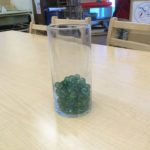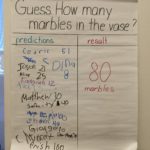Another Estimation Activity
On Monday, I wrote about a really interesting estimation activity that one of my students worked on in her student teaching classroom. Today, I want to show you another estimation activity that is an example of what I see much more frequently.
For this activity, the teacher put marbles in a large glass vase. The children each then had a turn to “estimate” how many marbles were in the jar. Seems simple enough. However, let’s take a look at how this differs from Monday’s example and why these distinctions are important. 
The first thing to notice that even as an adult, you couldn’t possible estimate how many marbles are in the vase. It really wouldn’t even be an estimate as much as it would be a guess, and a pretty random one at that. The smaller jars with fewer items makes far more sense for young children. Most three and four years olds can’t even imagine what 45 or 70 marbles look like since they probably haven’t developed a solid sense of number that big. And remember, just because children can count to 45 does not mean they have any concept of what 45 is.
Each child had an opportunity to write their name and their guess on a large graph that the teacher hung in the classroom.

I love that the children wrote their names and their numbers but you can see that their “estimates” are not even close. This takes us back to the original intention of the activity. If the learning outcome for the children was to write their names and a number then the learning outcome was met. If the learning outcome was about estimation, I am not so sure.
The teacher wrote the word “Predictions” on top of the first column. Was this a prediction activity? A prediction is a guess about the future, so this language is not quite correct. We want to be sure to use exact and correct language with children all of the time. This is especially true when we design an activity and the results of that activity will be a part of the classroom over time. Having this graph up in the classroom may reinforce misunderstandings about what a prediction is, and it doesn’t say anything about estimation.
Thoughts?
Nanette this look like fun for all even the teachers to see what the children guess is of how many in a jar.
Nanette this is a really cool activity! I totally understand what you mean about the language being so crucial for a lesson like this. We did a similar activity in my class. We were given a sheet of bubble wrap and were told to estimate how many total bubbles are on the sheet. Our teacher explicitly told us to estimate and try to problem solve how we would get the solution. I feel as though if she had told us to \”guess\” or perhaps to \”predict\” we would not have attempted to problem solve has we had. I am a student studying to become a teacher and I have encountered several situations in my practicum where language effected the results of a lesson. It is so important to say exactly what we want our students to do and to make it as explicit as we can to avoid any misconceptions. One of my favorite memories of practicum in regards to language is when I was teaching them a lesson and asked the students to \”run\” back to their desk to get a pencil. I obviously didn\’t mean for them to actually \”run\” to their desk but they took me literally. I corrected myself and explained they were not to run but overall it gave me a very rude awakening to just how much students respond to our language. Overall, great activity tho!
This is a good activity! It allows for the teachers to see their students have a number sense, and it it awesome to see each child is different in their prediction.